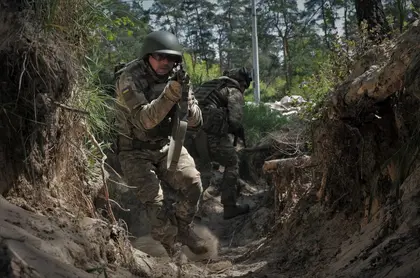Estonia’s General Staff says that Ukrainian troops may make significant progress in the counteroffensive before winter as they have an advantage over Russian forces in long-range artillery, precision strikes, and good combat intelligence.
According to the Estonia Defense Forces, Ukraine’s military knows how to make use of these strengths to make a possible strategic breakthrough, although Russia’s dug-in status is slowing down the advance.
JOIN US ON TELEGRAM
Follow our coverage of the war on the @Kyivpost_official.
During an appearance on Estonian National Broadcasting on Monday, August 7, Colonel Mart Wendla, Deputy Chief of Estonia’s Defense Forces General Staff, said “they certainly have a chance” to make a breakthrough by winter.
Wendla highlighted the uneven defense along the 1,000-kilometer front line but said the Ukrainian Armed Forces (AFU) excel in detecting breaches in Russia’s defenses, displaying superior training in small unit tactics, delivering precise fire strikes, and possessing better intelligence.
Nevertheless, the Estonian General Staff representative noted that Russian forces considerably fortified their defenses after their withdrawal from Kherson.
“While other regions have an average of 400 defense facilities per region, Zaporizhzhia has 1,400. This shows the depth of the defense structure. Ukraine’s task is exceptionally challenging in this regard,” he said.
According to Wendla, Russian defensive fortifications include extensive ditches, various minefields, defensive trenches, artillery positions, and reserve areas that will hinder breakthrough attempts.

Diane Francis Interviews Mikhail Zygar, Yaroslav Trofimov on Prospects of Russia’s War on Ukraine
Despite Ukrainian forces not yet breaching the first line of defense, they have achieved modest successes, he said.
“This effort spans a broad scope since Ukraine aims to divert attention in multiple directions. Russia pursues a similar strategy, recognizing the strategic importance of Ukraine's southern direction,” Wendla said.
“Russian activity is noticeable in the northern direction, attempting to tie up forces and prevent reserves from aiding a potential southern breakthrough.”
Wendla said Ukraine’s recent capability to pose long-range threats to the Russian fleet through drone attacks. He also speculated that the drones targeting Moscow likely launched from within Russia, but the instigators remain unclear.
“Nonetheless, the frequent explosions in Moscow underscore the inadequate structure of Moscow’s air defense system to modern threats,” the colonel said.
The AFU’s counteroffensive began in early June and Ukrainian troops have achieved success in the southeast, reclaiming several settlements.
Still, a portion of the AFU remains on the defensive due to the Russian army’s concentrated efforts in the Lyman-Kupiansk sector.
You can also highlight the text and press Ctrl + Enter






